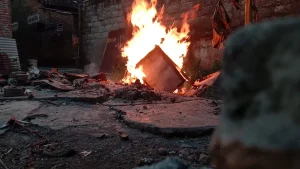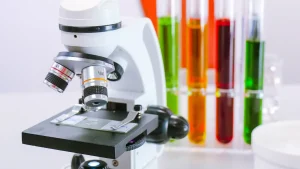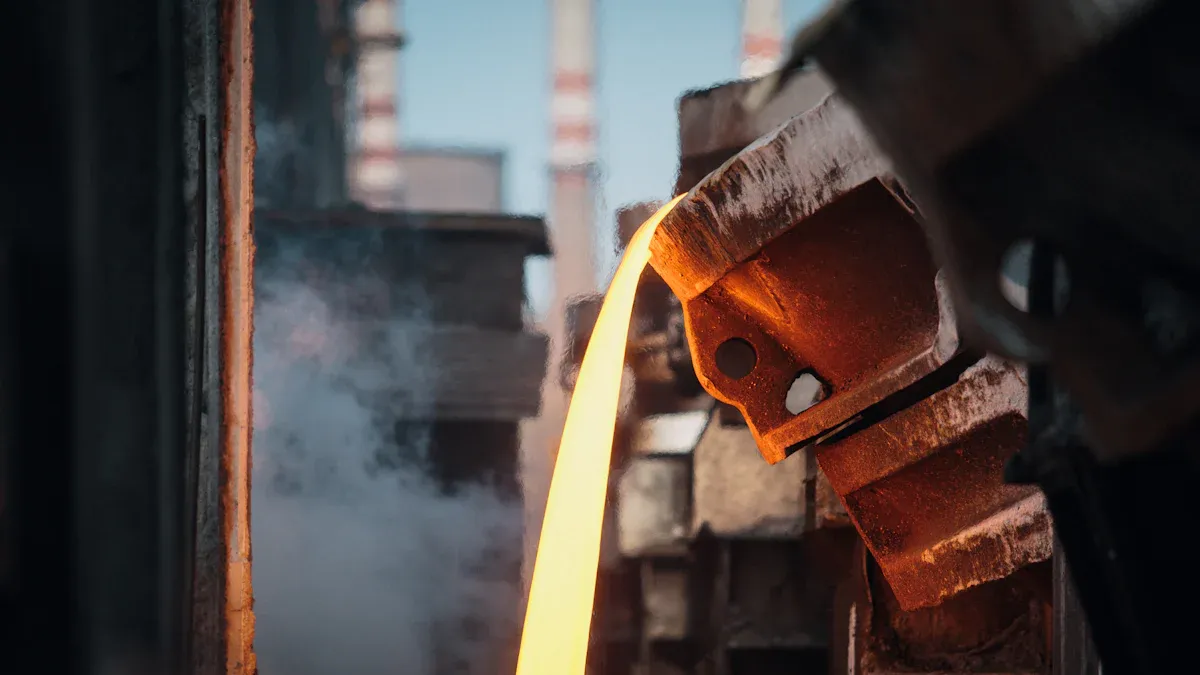
Graphite crucibles are essential components in high-purity metallurgical operations, renowned for their ability to endure extreme temperatures ranging from 1,800°C to 2,800°C. This makes them vital for metal melting processes. When selecting a graphite crucible, several critical factors must be considered:
- Material properties, such as thermal conductivity, play a key role in ensuring efficient heat transfer.
- The size and shape of the crucible significantly influence pouring efficiency and compatibility with various furnaces.
- Proper maintenance practices, including preheating and cleaning, are crucial for extending the lifespan and maintaining optimal performance.
These considerations are integral to achieving precision and durability in demanding industrial environments. Whether utilizing a graphite heater, graphite block, or GRAPHITE SUSCEPTOR, Ningbo VET Energy Technology Co., Ltd provides reliable solutions tailored to meet the needs of advanced applications.
Key Takeaways
- Pick a graphite crucible by its material, size, and shape.
- Clean it often and heat it slowly to make it last.
- Buy from a trusted maker who ensures quality and custom options.
What Is a Graphite Crucible?
Definition and Key Features
A graphite crucible is a container specifically designed for melting and casting metals at high temperatures. It is made from high-purity graphite, which consists of 99% pure carbon. This material offers exceptional thermal conductivity and electrical resistivity, making it ideal for extreme temperature applications.
Graphite crucibles come in various grades and compositions to suit different metallurgical processes. For example:
- High-purity graphite crucibles have a glossy black appearance and are suitable for precise, high-temperature operations.
- Clay-graphite crucibles, which contain 30-50% clay and 50-70% carbon powder, are more porous and appear matte grey.
These crucibles can also be machined to finer tolerances, ensuring compatibility with specialized equipment.
Why Graphite Crucibles Are Essential for High-Purity Applications
Graphite crucibles play a critical role in high-purity metallurgical applications due to their unique properties. The table below highlights their primary functions and benefits:
| Function/Benefit | Description |
|---|---|
| Exceptional Heat Resistance | Withstands thousands of degrees without structural changes. |
| Chemical Inertness | Minimizes contamination risks during melting due to low reactivity. |
| Thermal Stability | Retains shape and structure despite repeated heating and cooling cycles. |
| Lightweight | Easier to handle compared to metallic alternatives. |
| High Melting Point | Suitable for metals with superior melting points. |
| Impressive Mechanical Strength | Maintains functionality under temperature fluctuations. |
| Long Lifespan | Durable and cost-effective, reducing the need for frequent replacements. |
These attributes make graphite crucibles indispensable for industries requiring precision and purity, such as aerospace, electronics, and advanced metallurgy.
Material Properties of Graphite Crucibles
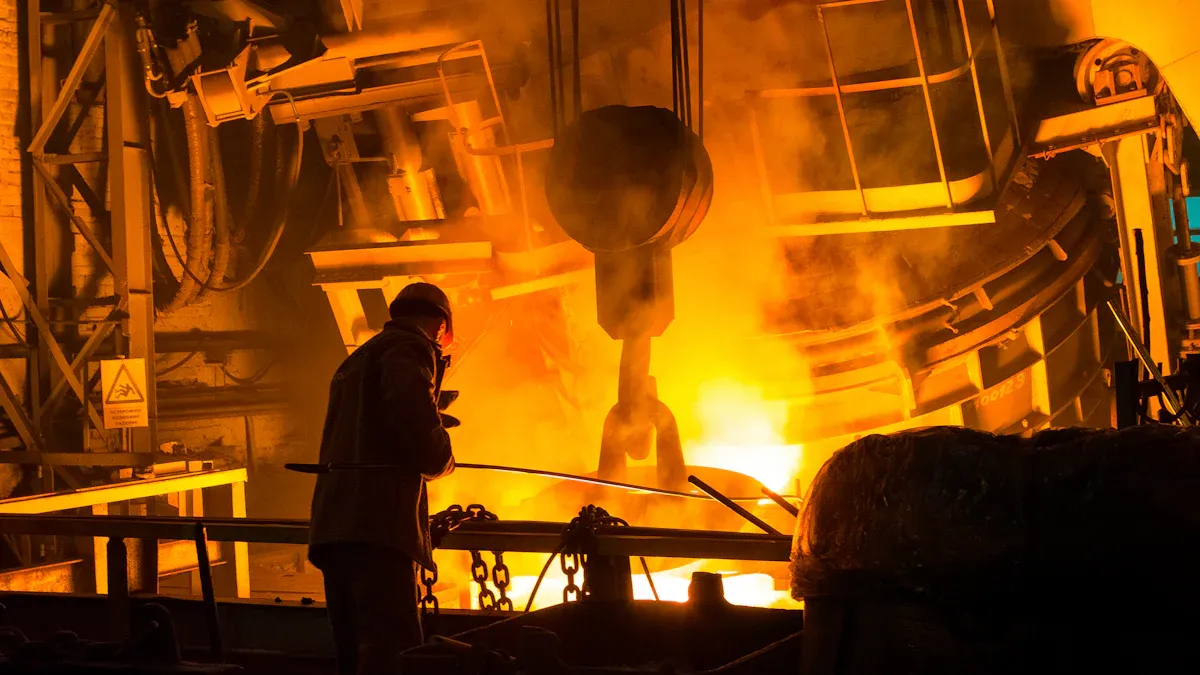
Thermal Conductivity and Heat Resistance
Graphite crucibles excel in high-temperature environments due to their remarkable thermal conductivity and heat resistance. These properties enable efficient heat transfer, ensuring uniform melting and casting processes. Graphite’s melting point ranges between 3,600–4,200°K (approximately 6,000–7,000°F), making it suitable for extreme conditions.
Graphite crucibles, known for their exceptional thermal stability, can endure temperatures up to 3,000°C (5,472°F).
Unlike ceramic or metal alternatives, graphite crucibles resist contamination and heat stress, making them ideal for melting metals like aluminum, copper, and brass. Their ability to withstand thermal expansion and contraction without cracking ensures reliability in demanding applications.
Chemical Stability and Impurity Reduction
Graphite crucibles maintain chemical stability even under extreme conditions, minimizing contamination risks during high-purity metallurgical processes. Made from high-purity graphite raw materials, typically over 99% carbon, these crucibles exhibit low reactivity with molten metals and other substances.
| Standard | Application | Impurity Requirement |
|---|---|---|
| IATF 16949:2016 | Automotive | < 50 ppm |
| SEMI F47 | Semiconductor | Compliance required |
| ASTM C709 | Aerospace | Density ≥ 1.85 g/cm³, Thermal Conductivity > 120 W/m·K |
| GB/T 3521-2023 | Battery-grade Graphite | ≤ 10 ppm metallic impurities |
| NADCAP | Defense | Accreditation required |
These stringent standards highlight the importance of impurity reduction in industries like aerospace and semiconductors. Graphite crucibles meet these requirements, ensuring consistent performance in high-purity applications.
Mechanical Strength and Longevity
Graphite crucibles demonstrate impressive mechanical strength, allowing them to withstand temperature fluctuations and mechanical stresses. Studies show that Syncarb Z2 e2 crucibles have a 56% higher three-point transverse bending strength compared to other crucibles, indicating superior durability.
| Evidence Type | Details |
|---|---|
| Mechanical Strength | Higher tolerance to mechanical stresses. |
| Oxidation Resistance | Lower losses after exposure to oxidizing atmospheres at 750°C. |
| Thermal Conductivity | Enhanced heat transfer efficiency over time. |
| Longevity Improvement | Field trials showed significant cost reductions due to extended lifespan. |
These attributes make graphite crucibles a cost-effective choice for industries seeking durability and reduced operational costs. Their longevity ensures fewer replacements, saving time and resources in the long run.
Temperature Limits and Compatibility
Maximum Operating Temperatures
Graphite crucibles are engineered to withstand extreme temperatures, making them indispensable for high-temperature metallurgical applications. Research demonstrates that these crucibles can operate effectively within a temperature range of 1,057–1,550°C. During rigorous thermal cycles, they maintain structural integrity without cracking, even under intense heat. This durability highlights their suitability for containing phase change materials like Fe–26Si–9B.
Comparative studies further emphasize the impressive temperature tolerance of graphite crucibles. High-purity variants can endure temperatures up to 3,000°C in controlled environments, while standard graphite crucibles perform reliably up to 1,800°C. However, exposure to air above 500°C can lead to oxidation, necessitating the use of inert atmospheres for optimal performance.
| Crucible Type | Max Temperature (°C) | Oxidation Resistance | Applications |
|---|---|---|---|
| Graphite Crucible | Up to 1800 | Susceptible to oxidation in air above 500°C | Metal casting, alloy production, non-ferrous metal smelting |
| High-Purity Graphite | Up to 3000 | Requires inert atmosphere to prevent oxidation | Melting metals like aluminum, copper, brass |
Compatibility with Metals and Other Materials
Graphite crucibles exhibit exceptional compatibility with a wide range of metals and materials, making them a versatile choice for various industries. Their ability to withstand temperatures up to 5,000°F (2,760°C) and 3,000°C (5,472°F) for high-purity variants ensures reliable performance in demanding applications. These crucibles also demonstrate excellent thermal conductivity, enabling efficient heat transfer during melting and casting processes.
Their chemical resistance further enhances their reliability. Graphite crucibles resist acids, alkalis, and corrosive environments, minimizing the risk of chemical reactions with molten metals. This property makes them ideal for melting non-ferrous metals like aluminum, copper, and brass.
| Property | Evidence |
|---|---|
| Temperature Resistance | Can withstand temperatures up to 5000°F (2760°C) and 3000°C (5472°F) for high-purity variants. |
| Thermal Conductivity | Exhibits excellent thermal conductivity for efficient heat transfer. |
| Chemical Resistance | Highly resistant to acids, alkalis, and corrosive environments. |
| Mechanical Strength | High mechanical strength to withstand physical stress during use. |
| Applications | Ideal for melting metals like aluminum, copper, and brass in high-temperature processes. |
Preventing Thermal Shock and Oxidation
Thermal shock and oxidation are two primary challenges faced by graphite crucibles during high-temperature operations. Rapid temperature changes can cause thermal shock, leading to cracking or structural failure. To mitigate this risk, manufacturers recommend gradual preheating of the crucible before introducing molten materials. This practice ensures even heat distribution and reduces stress on the material.
Oxidation occurs when graphite reacts with oxygen at elevated temperatures, particularly above 400°C. To combat this, high-purity graphite crucibles often feature protective coatings like silicon carbide or boron nitride. These coatings enhance oxidation resistance and prolong the crucible’s lifespan.
| Aspect | Description |
|---|---|
| Thermal Shock Damage | Reduces risk of crucible failure during rapid temperature changes. |
| High-Temperature Resistance | High-purity graphite ensures structural integrity under extreme temperatures, reducing thermal decay. |
| Oxidation Mitigation | Antioxidant coatings like silicon carbide and boron nitride protect against oxidative damage. |
| Coating Type | Benefits |
|---|---|
| Silicon Carbide | Excellent thermal shock resistance and high melting point, effective in high-temperature environments. |
| Boron Nitride | Exceptional chemical inertness and thermal conductivity, ideal for protecting against degradation. |
By addressing these challenges, graphite crucibles maintain their performance and durability, ensuring consistent results in high-purity metallurgical applications.
Selecting the Right Size and Shape
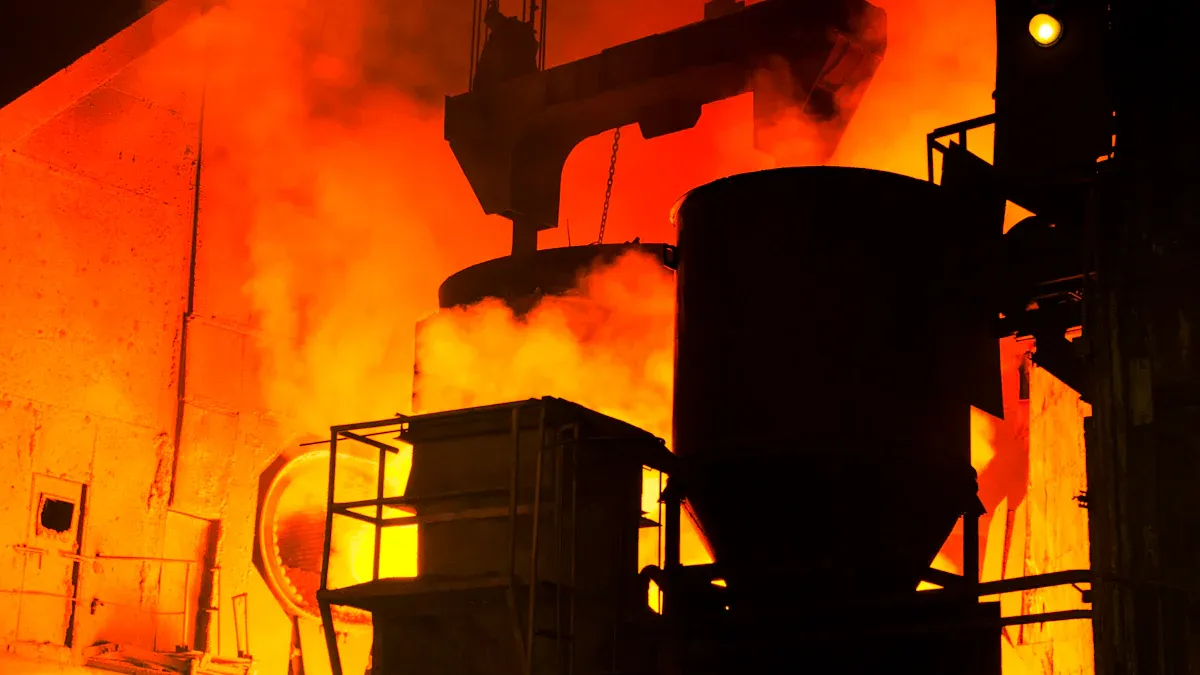
Importance of Size for Application Efficiency
Choosing the correct size of a graphite crucible is essential for optimizing performance in metallurgical applications. The size directly impacts energy utilization, material compatibility, and operational efficiency. A crucible that is too large may waste energy, while one that is too small can limit capacity and lead to inefficiencies.
Key studies highlight the importance of size selection:
- Proper sizing enhances energy efficiency and reduces material waste.
- Compatibility with the furnace and the material being processed ensures smooth operations.
- Tailored dimensions improve workflow and application-specific performance.
Efficiency data further supports this. For instance, optimizing the crucible’s thickness and dimensions can significantly improve charge energy utilization, as shown below:
| Crucible Configuration | Charge Energy Utilization (%) |
|---|---|
| Initial size (t1 ≈ 15 mm, t = 17.5 mm) | 27.1 |
| Optimized (t1 = 5 mm, t = 10 mm, d1 = d2 = 0.4 mm) | 34.04 |
| Stable range for d2 | 4–6 mm |
Common Shapes and Their Applications
Graphite crucibles come in various shapes, each suited for specific applications. The most common shapes include cylindrical, conical, and rectangular designs. Cylindrical crucibles are ideal for melting metals like aluminum and copper due to their uniform heat distribution. Conical shapes are preferred for precision casting, as their tapered design facilitates easy pouring. Rectangular crucibles are often used in batch processing, where larger volumes of material need to be handled efficiently.
Selecting the right shape ensures compatibility with the furnace and the material being processed. It also minimizes waste and enhances the overall efficiency of the operation.
Customization for Specialized Needs
Standard graphite crucibles may not always meet the unique demands of specialized industries. Customization allows manufacturers to tailor crucibles to specific requirements, such as size, shape, and material composition. This flexibility is particularly valuable in industries like solar panel manufacturing, jewelry making, and academic research.
Case studies demonstrate the benefits of customization:
| Industry | Testimonial |
|---|---|
| Engineer-Ceramics Industry | FS Graphite’s crucibles have exceeded our expectations, offering both durability and reliability. The team’s willingness to collaborate on custom designs has helped us optimize our workflows. |
| Solar Panel Manufacturing | We were facing challenges in sourcing graphite crucibles that could handle the demanding conditions of our solar panel production process. FS Graphite’s wholesale supply of high-purity graphite crucibles has been a game-changer. |
| Foundry Industry | As the manager of a large foundry, we rely on high-quality crucibles to ensure that our melting and casting processes run smoothly. FS Graphite has consistently delivered durable crucibles that withstand intense heat and pressure. |
Customization ensures that graphite crucibles meet the exacting standards of high-purity applications, enhancing both performance and reliability.
Maintenance Tips for Graphite Crucibles
Cleaning and Storage Best Practices
Proper cleaning and storage practices are essential for maintaining the performance and longevity of graphite crucibles. Regular cleaning after each use removes contaminants that could compromise the purity of future processes. Storing crucibles in a dry environment prevents moisture absorption, which can lead to internal cracks. Handling crucibles with care minimizes the risk of impact damage.
| Maintenance Practice | Description |
|---|---|
| Regular Cleaning | Clean the crucible after each use to remove contaminants and extend its lifespan. |
| Storage Conditions | Store in a dry environment to avoid moisture absorption, which can cause internal cracks. |
| Avoiding Impact Damage | Handle with care to prevent impacts that could compromise structural integrity. |
Additional guidelines include storing crucibles away from corrosive substances and excessive heat. Using clean gloves or specialized tools during handling prevents contamination. Regular inspections ensure the crucibles remain suitable for high-purity applications.
Avoiding Common Causes of Damage
Graphite crucibles are durable but can suffer damage from improper handling or environmental factors. Thermal shock, caused by rapid temperature changes, is a common issue. Gradual preheating before use reduces this risk. Oxidation, another concern, occurs when crucibles are exposed to air at high temperatures. Protective coatings like silicon carbide can mitigate this problem.
Physical impacts also pose a threat. Dropping or mishandling crucibles can lead to cracks or structural failure. Operators should always use appropriate tools and avoid direct contact with the crucible surface to maintain its integrity.
Extending Crucible Lifespan
Extending the lifespan of graphite crucibles requires consistent maintenance and adherence to best practices. Cleaning and inspecting crucibles regularly ensures they remain free of contaminants and physical defects. Storing them in optimal conditions, such as dry and temperature-controlled environments, prevents degradation.
Using crucibles within their specified temperature limits also enhances durability. Overheating or exposing them to incompatible materials can shorten their lifespan. By following these measures, industries can maximize the efficiency and cost-effectiveness of their graphite crucibles.
Comparing Graphite Crucibles to Alternatives
Graphite vs. Ceramic Crucibles
Graphite crucibles and ceramic crucibles differ significantly in their performance metrics, especially in high-purity applications. Ceramic crucibles, such as those made from silicon carbide or zirconia, offer higher oxidation resistance and longer melting cycles for specific metals like rhodium. However, graphite crucibles excel in thermal conductivity and chemical stability, making them ideal for processes requiring uniform heat distribution and minimal contamination.
| Material | Performance Metric | Comparison to Graphite |
|---|---|---|
| Silicon Carbide | 15-20% higher oxidation resistance at 1,600°C | Superior in high-purity applications |
| Quartz | Dominates polysilicon production (92%) | Graphite use negligible in this market |
| Zirconia | 30% longer melting cycles in rhodium processing | Better longevity in platinum group metals |
| Molybdenum | Survives 50+ cycles in aerospace alloys | Graphite typically 15-20 cycles |
| Tungsten | Withstands 2,200°C for rare earth separation | Graphite sublimates at these temperatures |
While ceramic crucibles may outperform graphite in specific niche applications, graphite crucibles remain the preferred choice for industries requiring high thermal conductivity and chemical inertness.
Graphite vs. Metal Crucibles
Graphite crucibles outperform metal crucibles in several key areas, including purity retention and operational efficiency. Metal crucibles often introduce impurities during melting due to their reactivity with molten materials. In contrast, graphite crucibles maintain high purity levels, ensuring contamination-free processes.
| Feature | Graphite Crucibles | Metal Crucibles |
|---|---|---|
| Thermal Endurance | High thermal endurance | Varies by metal type |
| Chemical Stability | Excellent chemical stability | Limited, varies with metal |
| Purity Retention | High purity retention | Often lower due to metal contamination |
| Permeability | Low permeability, easy to clean | Higher permeability, harder to maintain |
| Abrasion Resistance | Exceptional abrasion resistance | Varies, generally lower |
| High-Temperature Resistance | Suitable for extreme conditions | Limited by melting point of metal |
Pyrolytic graphite crucibles, in particular, exhibit superior thermal endurance and chemical stability. Their low permeability ensures material integrity, making them indispensable for high-purity applications.
Why Graphite Is the Preferred Choice for High-Purity Applications
Graphite crucibles offer unmatched advantages in high-purity applications. Their superior thermal shock resistance allows them to endure rapid temperature changes without cracking. They also exhibit excellent corrosion resistance, prolonging their service life in harsh chemical environments.
- High thermal conductivity ensures efficient heat distribution, leading to quicker and more uniform heating during high-temperature processes.
- Although the initial cost of graphite crucibles may be higher, their durability and performance in repeated applications result in long-term savings.
- Industries benefit from reduced replacement and maintenance costs, making graphite crucibles a cost-effective solution.
These attributes position graphite crucibles as the optimal choice for industries like aerospace, electronics, and advanced metallurgy, where precision and purity are paramount.
Choosing a Reliable Graphite Crucible Manufacturer
Importance of Quality Assurance and Standards
A reliable manufacturer prioritizes quality assurance to deliver consistent and high-performing graphite crucibles. Adherence to rigorous standards ensures that each product meets the demands of high-purity metallurgical applications. Manufacturers often implement the ISO 9001 quality management system to maintain product stability and reliability.
Key practices that highlight quality assurance include:
- Sourcing raw materials from certified suppliers and testing them upon arrival.
- Utilizing advanced testing equipment to measure machining accuracy and product performance.
- Conducting comprehensive inspections on finished products to ensure compliance with industry standards.
| Certification | Quality Assurance Practice |
|---|---|
| ISO | Each step of production and finished products undergoes inspection by the QC department before storage. Non-conforming goods are not allowed in the completed goods warehouse. |
These measures ensure that graphite crucibles meet the stringent requirements of industries like aerospace, electronics, and metallurgy.
Evaluating Manufacturer Reputation and Support
A manufacturer’s reputation reflects its commitment to quality and customer satisfaction. Reliable manufacturers offer products with exceptional strength, high thermal conductivity, and resistance to thermal shock. These attributes ensure durability and efficiency in high-temperature applications.
| Metric | Description |
|---|---|
| Product Strength | The crucibles are known for exceptional strength, ensuring reliability in high-temperature applications. |
| Thermal Conductivity | High thermal conductivity allows for efficient heat transfer during industrial processes. |
| Resistance to Thermal Shock | The crucibles can withstand extreme temperature changes without failing, enhancing their reliability. |
| Custom Manufacturing Services | Flexibility in design to meet specific customer needs, indicating a commitment to customer satisfaction. |
| Global Distribution Network | Ensures reliable supply and access to products across different regions, enhancing trustworthiness. |
| Commitment to Sustainability | Adherence to environmental standards throughout the product lifecycle, reflecting responsible manufacturing practices. |
Additionally, manufacturers that provide technical assistance, product training, and troubleshooting support demonstrate a strong commitment to customer success.
Why Ningbo VET Energy Technology Co., Ltd Is a Trusted Supplier
Ningbo VET Energy Technology Co., Ltd stands out as a trusted supplier of graphite crucibles. The company’s dedication to quality assurance ensures that each product meets the highest industry standards. By sourcing raw materials from certified suppliers and conducting rigorous inspections, they guarantee the reliability of their products.
Their graphite crucibles exhibit exceptional thermal conductivity, chemical stability, and resistance to thermal shock, making them ideal for high-purity applications. The company also offers custom manufacturing services, allowing clients to tailor products to their specific needs. With a global distribution network and a commitment to sustainability, Ningbo VET Energy Technology Co., Ltd provides reliable solutions for industries worldwide.
Selecting the right graphite crucible ensures optimal performance in high-purity metallurgical applications. Its superior thermal conductivity, chemical stability, and durability make it indispensable for industries requiring precision.
| Crucible Type | Advantages | Disadvantages |
|---|---|---|
| Graphite Crucible | Excellent for high-temperature melting, faster heat conductivity | More expensive than clay crucibles |
| Clay Crucible | Ideal for low to medium temperature ranges | May crack under extreme heat |
Partnering with a trusted supplier like Ningbo VET Energy Technology Co., Ltd guarantees quality and reliability, ensuring long-term success in demanding industrial environments.
FAQ
1. How do you prevent oxidation in graphite crucibles?
Use an inert atmosphere or apply protective coatings like silicon carbide. These methods reduce exposure to oxygen, extending the crucible’s lifespan during high-temperature operations.
2. Can graphite crucibles handle all types of metals?
Graphite crucibles work well with non-ferrous metals like aluminum and copper. However, they may not suit metals requiring extreme oxidation resistance, such as platinum.
3. What factors affect the lifespan of a graphite crucible?
Proper maintenance, gradual preheating, and avoiding rapid temperature changes significantly impact durability. Storing crucibles in dry, controlled environments also prevents moisture-related damage.

